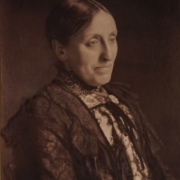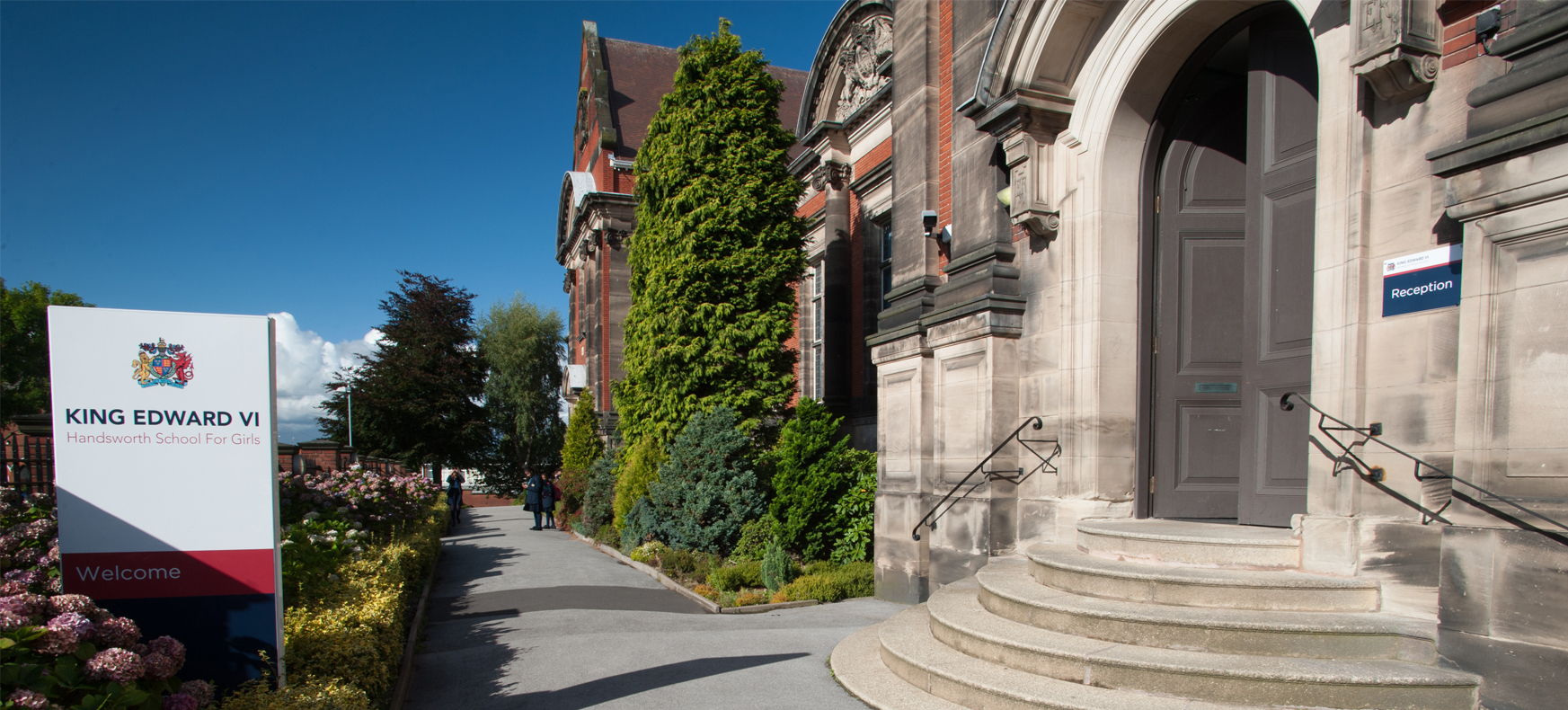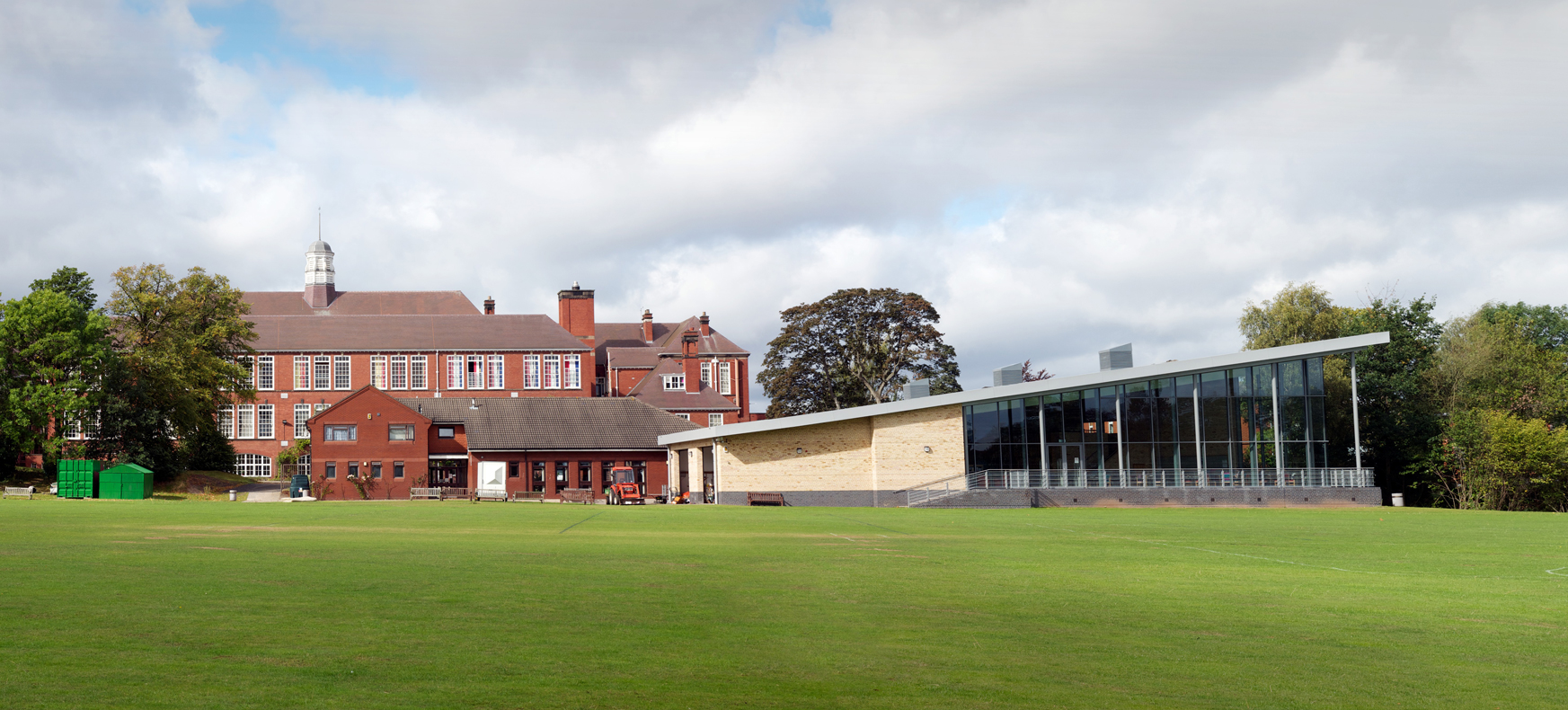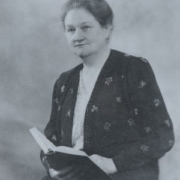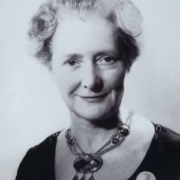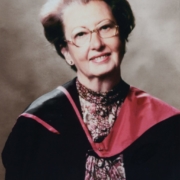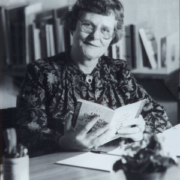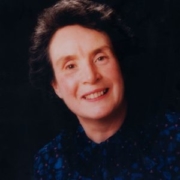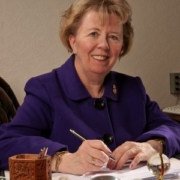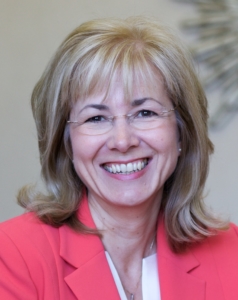In the early days the forms were numbered in reverse with the first year being VII and the Upper Sixth I but this was changed in 1917. Until the 1960’s the girls were in four ability streams but this was dropped as it led to intellectual snobbery. By the early 1970s the forms were labelled ABCD, EFGH etc. and by the 1990s the only setting left was in mathematics. Following the introduction of the National Curriculum in the 1980s the years were renamed so that a girl enters into Year 7. The first year had been Year III and two years later a girl could be in the third year, Upper Fourth or Year 9 which was very confusing. The forms in the early days were about the same size as today but the Sixth Form very small – about six girls in each year. Transfer to the High School was not unusual.
School fees of thirty shillings a term (£1.50) had to be paid in 1911 but about a quarter of the girls won scholarships and others received Local Authority awards for intending teachers. These girls also received assistance with buying text books; text books could also be rented from school. Text books only became free after the 1944 Education Act although exercise books had become free by the 1920’s.
The school day originally began at nine o’clock and there was a long lunch break from one to two-thirty to enable girls to go home for lunch. There were five lessons in the morning and two in the afternoon which were mainly practical or science lessons or private study; older girls were allowed to study at home. Girls who were not strong were allowed half days and others were kept at home in the afternoon to help their mothers in the house. By the 1930’s the school day had become more as we know it but Thursday afternoon remained free until about 1963.
The curriculum a hundred years ago was not too dissimilar to today although practical subjects were only offered to girls not deemed capable of following a full academic curriculum and there was an emphasis on arts subjects. Relatively little science or creative/practical teaching took place.
Lessons were more formal than nowadays. Girls sat alphabetically in rows, were expected to absorb masses of factual information, and received little support if they did not understand. Lessons were taught in form rooms with mistresses, not girls, moving and the gong (still in the entrance hall) was rung when lesson changes took place. Bells were installed in the 1930’s. In the early days the form teacher would teach a variety of subjects to her own class.
Of course there were few visual aids in the early days, no videos, audio tapes or computers. Teacher input was paramount and there was a lot of note-taking. The girls also learned long passages from Shakespeare and the Bible by heart. The atmosphere in the school was highly academic and competitive. Form lists in merit order were compiled each week and read out to each class by Miss Nimmo. Merit marks based on the previous week’s marks were read out in Monday assembly.
There were school examinations at the end of each term. Lists were displayed in each form room and form positions read out to the assembled school in the hall by Miss Nimmo, which must have been terrifying. Girls could move up a year in January if they did well but weaker girls would remain down and repeat the work.
Public examinations were taken from the early days. Prior to 1918 girls took an examination called Junior Cambridge. The Birmingham University Matriculation Examinations were taken after either one or two additional years. In those days the few girls who went to university tended to go to their local one. In 1918, School Certificate was introduced. To get this, girls had to pass at least five subjects from at least three different groups (to keep the curriculum broad) and gain a credit in at least one. Most girls took at least eight subjects and if one was failed, they all had to be retaken the following year. Five or six credits were needed for university entrance. In 1921 Higher School Certificate was introduced and three main subjects and one subsidiary one were taken. In 1951 the General Certificate of Education was introduced which was less restrictive. It remained in place at Ordinary and Advance Levels until the 1980s when O Levels were replaced by GCSE.
Speech Day
The culmination of the academic year was Speech Day. When the school was at Aston, Speech Day was held in the Midland Institute. At Handsworth all girls attended and wore white dresses with red bows until the 1930’s. The school song, ‘Come, sing the song of Handsworth School’ was sung until the present anthem was suggested by Miss Bamforth (Headmistress) in 1942. Speech Day is still held in the hall each December and remains a grand and formal occasion.
The arts
In the early days art lessons were very formal and photographs show a classroom with rows of easels and Old Masters on the walls. By the Second World War there was greater freedom of activity.
Drama has been a long-standing tradition. The earliest play on record is Iphigenia in 1913 followed by Henry V a year later. It may be that the first joint production with Aston was Samson Agonistes in March 1924. Pupils were also taken to see plays including a visit to Stratford to see Romeo and Juliet in 1934. In 1917, an entertainment, which included scenes from Nicholas Nickleby and David Copperfield and nursery rhymes, raised £80 for the Lady Mayoress’ fund in aid of the war effort; a repeat performance was given to wounded soldiers stationed at Highbury Hall. A memorable staff play was also performed in 1917 to raise funds for St Dunstan’s Home for blinded soldiers and sailors. The House dramatic competition began in 1936 and continued into the 1960’s. The first opera to be performed was Orpheus and Eurydice in 1961 and the pantomime, Aladdin, in 1975, was the first of a series produced by Mrs Geoghegan,
In the early days, music really meant singing and it was taught by Mr Halford. Each year he composed a cantata for speech day. In the mornings, girls who could play the piano well were called upon to play the hymn in assembly and a suitable tune, not a march, while the girls left the hall. In the early days the piano was on the platform. The school orchestra began in about 1926. One of the earliest members was Dorothy Heath who played the violin and whose endowed prize is still awarded at speech day. The original orchestra had two flutes, a cello and seven violins (two of them teachers). Miss Rhodes gave violin lessons and charged 6d (2 ½ p). The orchestra declined during the 1930’s but has since revived and it is now a major strength of the school. Through the 1960’s and 1970’s additional instrumental teachers were appointed and we now have a range of orchestra, ensembles and choirs. In 1931 or 1932 the inter-house music competition began. From 1941 girls participated in the Secondary Schools Music Festival and had an opportunity to sing major choral and orchestral works. It continued until the city grammar schools were closed in 1974. In the 1970s the choir performed at the Alderley Edge Music Festival and the Llangollen Eisteddfod. In 1973 and1977 records were made and in 1981 the choir gave a half-hour radio concert.
Country dancing was greatly enjoyed in the early days in the playroom and girls also organised ballroom dancing there on wet days. Modern (creative) dance was not introduced until 1945 when the teachers were Miss Hyde and Miss Seagrief; the pianist, Miss Hooper, played for dance lessons from1944 to1981 at the school. The Evening of Dance which we still hold annually, has a long history and originally raised money for charity.
Sport
In the early days at Aston, exercise consisted of drill in the corridors and so the gym at Handsworth (the Music Room in later years) seemed wonderful. One of the girls who particularly enjoyed gymnastics was Elaine Stagg (1914-1917) who persuaded her father to present the cup still awarded at speech day. Girls were expected to climb ropes, walk along bars etc. At the end of term ‘shipwreck’ was played – a form of ‘tig’. Originally gym tunics were worn but by the 1930s blouses and knickers became the uniform. Talented gymnasts were invited to join the ‘badge division’, which met after school on Mondays. They wore a large badge on the left shoulder of their gym tunics. In September 1962 the new gymnasium was opened, a light and pleasant building with an excellent sprung floor.
Games activities were an important aspect of school life. In the early days the heroes of the schools were those who showed greatest prowess on the games field. Until the 1950s, reports on individual school team members appeared in the Beacon as did a sports report until the 1970s. Tudor Roses are awarded for outstanding contribution to school sport (in the early days they were real silver). When the school was at Aston, games were optional and an additional fee was charged. On site facilities are relatively recent. At first girls had to go to Grosvenor Road and then to Island Road. During the Second World War, the fields were taken over by the RAF as a barrage balloon site and games had to be played elsewhere. Hockey and netball were played in winter and tennis in summer. Rounders began in the 1920s, cricket was introduced in 1945 and badminton in the 1960s. On-site fields were constructed in the 1980s and now provide an excellent facility thanks to the efforts of our grounds staff. The annual tennis competition between Handsworth, Camphill and the High School, the Fry Cup, was inaugurated by Miss SM Fry to commemorate her term as Bailiff in 1912-1913; she was the first female governor of the Foundation.
Sports Day is a tradition going back to the earliest days of the school. It began with a gymnastics or dance display. In the First World War a military band played and tickets were sold to raise funds for the war effort – but only to female relatives! Various fun races were held in addition to the serious athletic events. During one of the events while the school was at Aston, Mr Jones, accidentally shot himself in the hand with the starting pistol. By the 1930s the event had become more serious.
Swimming galas were held in the early days at Grove Lane Baths and later at Woodcock Street. The school swimming team was very successful and a number of girls have competed at national and international standard.
Charity and Community
In the early years of the school, money collections seem to have dominated the school’s outreach work. The Missionary Society raised money for missions in China and India by the sales of sweets and needlework. In the First World War, money was collected for Belgian refugees and the Red Cross. Some needlework classes made garments for Middlemore Orphanage. In the early 1920s toys were taken to a working men’s club in a poor area of Bordesley Green. In 1925 parties of girls began to visit the Children’s Hospital and there was a collection for the cot fund which maintained a bed; on Monday morning each girl contributed a penny (less than ½ p today). During the Second World War the girls ran a nursery in Hockley in the school holidays. Harvest parcels for the elderly have been distributed for over a quarter of a century and today are sent out via the Wesleyan Holiness Church in Handsworth. Girls have sponsored children in the Third World, sung carols for Mencap and raised funds for a guide dog called, of course, Edward.
School visits
Opportunities for the girls have expanded over the years. In the early days school visits were fairly local, botany trips to Sutton Park being some of the first remembered. By 1920 there had been trips to Kenilworth and Lichfield and in 1924 a party paid a three-day visit to the British Empire Exhibition at Wembley. Through the 1920s opportunities expanded and old girls remember trips to Stratford, London and Dudley Zoo. The first trip abroad seems to have been in 1932 when Miss Thompson and Miss Wright took a party on a ‘Scholars’ Wonder Cruise’ to the western Mediterranean for the princely sum of £10! In 1937, school parties visited Paris and Coblenz. Only two years after the end of the Second World War, Miss Bamforth and Miss Evans took a party to St Die, which had suffered badly during the fighting, and a year later they went to Paris.
School Houses
School Houses were introduced at the beginning of the twentieth century to facilitate mixing across the years. They were named after famous women and each had its own colour – Nightingale mauve, Kingsley green, Fry pale blue and Browning brown. By 1913 there were house awards for netball, hockey, sport and tennis. There were House notice boards in the playroom and a conduct system was operated in Houses. There were also House Christmas parties. In 1939 the system was changed as the school had grown and eight Houses named after the royal Houses were formed. House Music and House Drama competitions were held in alternate years and there was even a wild flower competition. In 1952 a Flower Show began and, in the 1950s, an Art Competition. In 1976 the Houses were again rearranged to coincide with the forms and named after semi-precious stones because of the school’s proximity to the Jewellery Quarter – Amethyst, Coral, Garnet and Topaz.
Uniform
In the early days at Aston there was no uniform and girls wore white blouses and dark skirts. Then Miss Nimmo introduced uniform. By the end of the First World war, gym tunics had become the standard uniform worn with black woollen stockings and navy or black woollen knickers, summer or winter. Black felt hats were worn in winter and straw boaters in summer. Originally the hat bands were red and white but in about 1909 the colour was changed to wine red and blue – Miss Nimmo did not realise these were the colours of Aston Villa! – and to blue and green in about 1922. Gloves were always worn. Girls at this time usually wore their hair long, plaited or tied with a bow at the back. Blazers with badges were introduced in the 1920’s in response to pupil demand. By the 1930’s gym tunics were replaced by tunics with a square neck, fitted bodice and flared skirt. Summer dresses in a suitable style in any print were allowed – with the hated black stockings. In 1938 fawn lisle stockings or short socks were allowed, a major victory for the girls. After the Second World War, square-necked blouses were replaced by shirts and ties. Hats became optional and then disappeared and the requirement to change into indoor shoes has ended.
The journey to school
In the early days many of the girls walked to school, sometimes long distances. Others travelled on a four-horse bus. Until World War Two, girls came from Six Ways along Lozells Road on the tram (the terminus was at the end of Rose Hill Road) or from town along Constitution Hill ( the terminus was near the West Bromwich Albion ground. Many girls cycled to school which was much safer in those days as there was relatively little traffic; the cycle shed was eventually converted into a Sixth Form Common Room and is now the ground floor of the library. Girls also travelled by train, mainly from Sutton Coldfield, but in those days they were able to change trains at Aston and take a second one which dropped them at Handsworth Station (in a cutting in the park). Harborne girls got the train to Soho Road Station. Car journeys in those early days were exceptional. Miss Jeffrey (1918-1958) was the first member of staff to own a car – a bull-nosed Morris Cowley. Most of the staff lived nearby in lodgings.
School Clubs
By 1914 there was a debating society, missionary society, musical society and swimming club. The debating society met in what is now the resistant materials technology room but political or religious topics were banned. Amazingly, girls were reluctant to speak. The swimming club met at Grove Lane Baths (now converted to flats). An unusual club was the Kyrle Society which raised money to buy pictures for the school. Its annual dance was the highlight of the school year even though boys were not invited. It had ceased by World War Two. After World War One, a history society was formed and an arts and crafts club (1926) and puppet club (1937). The League of Nations Society was founded in 1932 and had over a hundred members. An interesting society was parliament; founded in 1934; membership was initially limited to the UV (Year 11) and Sixth Form. Girls each represented a constituency and debated issues of the day e.g. fox-hunting and euthanasia. A Guide Company flourished from 1939-1959 under Miss Pritchard (Music). In 1946 an art club was founded and in 1951 a geography society.
The First World War
The First World War was a worrying time for the school as many girls and staff had relatives fighting in the trenches or other war zones. The Beacons of that period contain a number of patriotic poems. A savings scheme to generate money for the war effort was introduced, girls made charity collections, left school to go into war work (sometimes with very distinguished service), swimming was cancelled as Grove Lane Baths were used as a billet for soldiers and the value of prizes at Speech Day was reduced. Cookery classes were reduced, school dinners became more frugal, the school became colder due to fuel shortages and uniform regulations were relaxed. The global influenza epidemic of 1918 caused the school to close a fortnight early for Christmas, speech day was postponed and two girls died. Peace was celebrated with a fancy dress party in September 1919. A collection raised £25 (a large sum in those days) to fund the Peace Memorial Prize, which is still awarded at speech day.
The Jubilee
The celebration of fifty years of existence took place in May 1933. The main event was a pageant presented in the school hall in which 250 girls presented scenes from the earliest days of education in Birmingham to the present time. Following the first performance, mistresses past and present gave a reception to former pupils. The Jubilee Loan and Gift Fund ‘ to provide a means of help for former or present pupils or members of staff of the Schools’ was begun. A church service was held on Sunday May 7 th at St Mary’s, Handsworth. On Tuesday May 8 th, a Thanksgiving Meeting for all the Foundation Schools was held in the Town Hall attended by past and present, pupils, staff and governors.
The Second World War – evacuation
With the threat of aerial bombardment of industrial targets and major cities, Birmingham was clearly a risky place in which to live and plans for the evacuation of school pupils began. As the threat of war increased, staff were recalled early from their holidays on the 26 th August 1939. Two days later a rehearsal of the planned evacuation of the school was held and the evacuation took place on Friday September 3 rd, two days before war was declared. Two hundred and fifty-eight apprehensive girls and thirty-four teachers and helpers were seen off from Snow Hill station. Others had been privately evacuated or chose to remain. The destination was Worcester Girls’ Grammar School. By 8.30 pm all the girls had a billet – then they realised they had forgotten the staff! It was not a happy time for many girls and some of them ran away, even walking the whole way home. Others, of course, settled in well and formed long-lasting friendships. Lessons took place from 2pm to 6pm daily and in the morning girls went to St George’s Church Hall where small classes were held, the Guides met and lunch was prepared. The Governors travelled out to Worcester for speech day. This period is known as the ‘phoney war’ and there were no air raids in Birmingham until August 1940. Girls began to drift back to Birmingham and by November Miss Davis and Miss Evans had returned to organise home study groups. Girls came to school twice a week to collect work and have some short lessons.
By April 1940 air raid shelters had been built at Handsworth and the school reopened. Two hundred girls returned with Miss Evans in charge and seven staff to assist her. In August the school moved back from Worcester. Many of the rooms on the ground floor had their ceilings reinforced to make them bomb-proof including the boiler room, the basement room in the library (then the bicycle shed) and the keyboard room (then the drying room). All the corridor windows were covered with adhesive net to prevent flying glass. There were many air-raid practices but only one real raid took place in the school day. After night-time air raids school opened an hour later to allow for disrupted sleep and difficult journeys.
A second evacuation was organised on the 26 th November 1940, this time to Coalville in Leicestershire. This was a very difficult time with poor accommodation and rather poor hospitality provided by the Grammar School. Miss Brew paid frequent visits to try to maintain morale and the kindness of Miss Davis is remembered. This evacuation ended in July 1941 and for the rest of the war the school remained in Handsworth.
Staff took it in turns to do fire watch duty at night to look-out for incendiary bombs. From the summer of 1942 onwards parties of girls went to various summer camps to help bring in the harvest: Henley-in-Arden for corn, peas and bean, Salford Prior for potato picking and Knightwick for hops. Collections of useful materials were made at school and a number of speakers came to inform the girls about aspects of the war. Girls in the school became very actively involved in the work of the AVF, an organisation of French people who established a centre of resistance. Both Miss Brew (Headmistress) and Miss Evans (French) were rewarded for their efforts by the French Government after the war and Miss Evans was made an ‘Officier de l’Academie’ by the Academie Francaise. Most school events took place despite the war. When the war in Europe ended the girls celebrated with two days holiday on the 8 th and 9 th May.
The threat to the grammar schools
By the 1920’s education for girls was relatively common and the Foundation, in financial trouble, decided to hand over control of its schools to the city. With what now seems extremely bad timing, the Bailiff, Dr Bernays, announced this at Speech Day on November 19 th 1920. Miss Nimmo, no longer Headmistress but a member of the audience, turned Speech Day into a protest that spread across the city.The problem had arisen because of improvements to accommodation in all the Foundation schools and a doubling of the teaching staff salary bill to bring teachers’ pay in line with national levels. The Foundation salary bill was £33 500 in 1916-17 but £66 000 in 1920-21. To meet their costs, the Governors, having failed to get a grant from the city, had decided to hand over the schools. Until that occasion, the Foundation governors had kept their plans secret but now it hit the press. Three days later a protest meeting was held at the school. Two petitions were drawn up that evening, one to the Governors asking them not to handover the schools (it had over 5 000 signatures when presented two days later), and a second to the Lord Mayor, showing that giving a grant to the Foundation would save the city money as some of the costs of educating the pupils in Foundation schools would be borne by the Foundation. A public meeting was held in the Town Hall in early December and by the end of January the Council had agreed to an annual grant of £35 000 (it would have cost £90 000 to take over the schools).
A second attempt by the Governors to divest themselves of the burden of the grammar schools was made in 1930, led by the new headmaster of King Edward’s School. A meeting of over seven hundred parents, staff and Old Edwardians took place in the Handsworth Hall and a committee was formed to ‘help’ the Governors. This campaign was again successful.
After the Second World War the main threat was the ending of selection. In 1965 a Labour controlled City Council voted to instigate city-wide comprehensive education. This threat was held off until 1970 when a battle ensued until June 1973. This was a temporary reprieve, for in October 1973 the Education Committee decided to ‘cease to maintain’ the grammar schools at Handsworth, Aston and Five Ways. The Foundation united in its defence: a petition with one hundred and fifty thousand signatures was drawn up; a car cavalcade stopped traffic in the city centre. Success was only temporary, for in 1977 Mrs Shirley Williams, Secretary of State for Education, issued an ultimatum to the Council to complete its programme of comprehensivisation. Things went quiet until 1981 when a new city plan for Sixth Form colleges threatened the schools. Fortunately in May 1982 the change in Council control saved the schools. Attempts in the 1990s and a decade later were again rebuffed with the level of support for the King Edward grammar schools being shown at meetings in the Town Hall and Council House and in the media.
